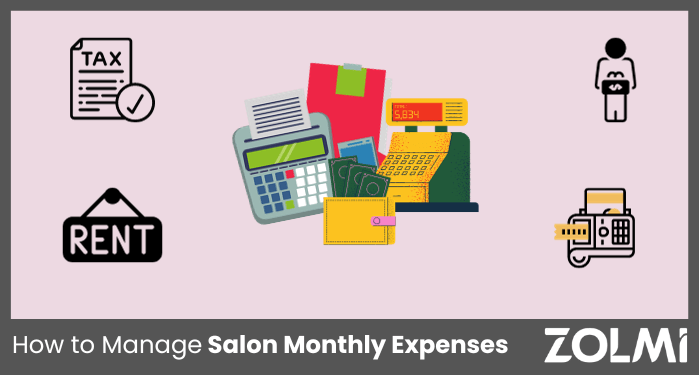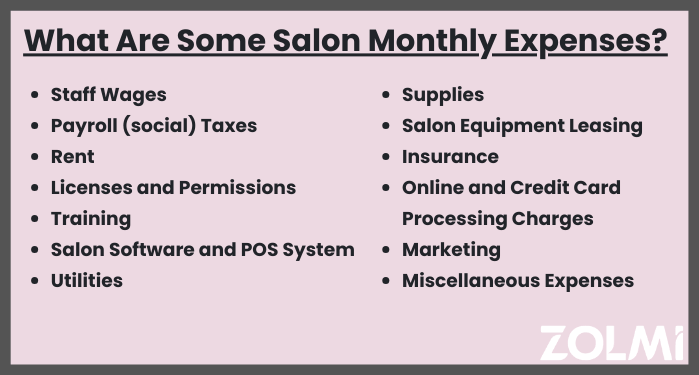How to Manage Your Salon Monthly Expenses in 2024


Salon expenses are one of the first things to consider when you get into the beauty industry. Opening and operating your own hair salon can be both exciting and fulfilling as a career, but it does take a bit of planning if you want to start off on the right foot.
It’s best to be organized, right from the start. This means understanding your basic startup cost, having an estimate of your salon budget each month, as well as considering what promotions and social media strategies you can use to create interest and promote your growing business. I know that it sounds like a lot at first, but good planning and an idea of the average cost of what you’ll need will make all of the difference and help you to grow your successful salon business.
In this article, we’ll take a look at the average costs per month that you’re likely to face as a salon owner, as well as some strategies to reduce your overall expenses while maximizing your salon’s potential.
Salon Overhead refers to a variety of different expenses, all of which are necessary to run a salon or spa. It includes the cost of new equipment or replacements, salon supplies and tools used during services, retail product inventory, salon software, and any products that your employees use on clients during a service.
Salon owners should also include the cost of licenses and permits, rent, payroll, insurance and taxes when calculating the overhead cost.

What is the largest expense in operating a salon? Wages. On average, a stylist in the U.S. makes a salary of almost $30,000 a year. Make sure to keep in mind the salary costs per year to pay other salon employees, too. Will you need cleaning staff, or a receptionist?
This cost can vary by location. It’s a good idea to research business taxes in your area. Check your state and city’s website to get a better idea of how much you’ll pay.
The costs of renting a hair salon space will vary a lot depending on your location. Figure out who your clientele will be. Don’t forget to ask what services (such as parking, maintenance, laundry access etc.) are included in your rent bills.
Running a salon requires proper licencing. You’ll need to make sure that you check your city or state’s website for a list of inspections, permits and fees and budget accordingly.
There are always new changes happening in the beauty industry and new equipment that can be added. Training isn’t free, but it’s also an investment. Work closely with your salon’s stylists to determine what they need (as well as what clients want). As a hair salon manager, it’s up to you to decide when to spend money on professional training.
You won’t regret spending money on software. You can track service appointments, retail sales, inventory, expenses, and your employees’ performance. A salon POS System will help you manage credit card payments, transactions and sales.
This expense includes heating, water and electricity costs. An average electricity bill usually costs around $150 per month, and water costs can range from $45 to $150, depending on the hair salon size and location.
This includes the costs of salon retail sales products as well as supplies salons use on clients during services.
Some salon owners choose to set up an account with a company that offers leasing options. This reduces the upfront cost to open your salon. You’ll pay regular bills for professional equipment, and have the option of paying off the balance at the end of the leasing period, or starting a new lease.
Insurance fees are necessary costs for all salons. These fees can range from around $500 to $700 for salon owners, depending on the salons services and location.
Different companies charge different processing fees, so make sure to shop around. These can range from 1.5% to 2.7%, but can sometimes be even higher.
Depending on your salon business strategy, clients, and how much work you want to put into it on your own, marketing costs can vary widely from almost free to quite expensive. Running your own website and marketing your salon space through emails won’t cost much money, but on the other hand, hiring a professional to put together ads can save time. As a hair salon owner, you’ll need to consider your overall salon expenses, income and savings when you plan your marketing strategy.
These are all of the other hair salon expenses that may come up unexpectedly. It’s a good idea to keep at least $500 in cash on hand to spend, along with the float in the till.
There are a range of expenses to consider. Renting a salon suite will cost a lot less than running a large spa, for instance. Many people ask “Is owning a hair salon profitable?” The answer is that it certainly can be.
Depending on the salon size, flow of customers, the space and equipment that you pay for, and your location, your salons average cost can range from as low as $50 a month to over $1000 a month. You can raise or lower your salon expenses depending on the staff (if any) on your payroll, whether you hire professionals or design marketing campaigns or a salon website or take advantage of free services, and what equipment or “extras” you provide to clients.
Do not miss our post on Salon Pricing Guide.
Understand What Drives Your Costs: Communicate and hold regular staff meetings. Learn what clients appreciate and where the biggest losses come from. Your staff are a valuable resource because they’re on the front lines and see what happens every day.
Use Salon Management Software and a POS System: This will save time, income, and your sanity. This software helps you set schedules, track bookings, see profits, check your stock of products and learn whether stylists are hitting their targets. POS Systems make taking payments faster and more efficient.
Salon Inventory: Manage inventory using salon software to avoid overordering, shortages or waste. Track your demand for each product and set min/max levels. Consider using smart ordering to automatically fill fast-moving product orders. Make sure to separate sales stock from products that stylists use.
Reduce Over-Staffing: Do you really need two receptionists? Are all of your stylists busy? Scheduling software and an online booking system can help reduce the need for extra staff and make sure that appointments are booked efficiently to avoid a lot of downtime.
Make Smart Use of Downtime: When your staff aren’t helping clients, ask them to help clean, place orders, update the salon’s website, etc. Encourage cooperation and teamwork.
Cross Train Your Staff: This will cut way down on over-staffing and downtime. Train everyone to help with things like working the till or updating the website. The more you empower your staff, the happier (and less stressed) everyone will be.
Retain Your Best Stylist: Maintain a good relationship with them and communicate frequently. Remember, it costs money to train and hire new staff, and it’s likely that they have a lot of loyal clients, too.
Reduce Administration Work: Cross training helps a lot with this. Your bottom line might be low because of redundant staff members. Remember, you can manage stock, book most appointments and balance your accounts online.
Educate Yourself: Do your homework. It’s possible to save a lot by finding cash discounts, bulk ordering prices or supplier loyalty plans. Additionally, find out what expenses you can claim on your taxes, later on.
Utilize Your Salon Space Well: Wasted space is wasted money down the line. Keep storage areas organized at all times so that everyone can see and find everything quickly. Make sure that you use work spaces efficiently, too. One backwash per three workstations is a good general rule.
Smart Salon Marketing: Loyalty programs, email advertising, reviews and referrals are all free. They’re also very effective. Salon software can help manage these easily.
Use a Salon Expenses Calculator: Regularly track your income and expenditures using a salon expense calculator. This way, you can see where you’re losing the most money and adjust if needed.
Salon Expense Spreadsheet: Combined with regular financial calculations, this will help you to stay on budget, track any improvements and be ready for tax season.
To learn more please check out our post on Hair Salon Budget Plan.
How much does it cost to run a small hair salon? That depends a lot on how much you’re willing to do yourself, how much teamwork you can encourage, and what your long term plan looks like. Communication with your staff and staying informed is key. With the right strategy, it’s possible to keep your salon monthly expenses low while not compromising on important things like service quality and client experiences.
Financial bootstrapping in small businesses: Examining small business managers' resource acquisition behaviors
https://www.sciencedirect.com/science/article/pii/S088395
Organisation capital and sticky behaviour of selling, general and administrative expenses
https://www.sciencedirect.com/science/article/pii/S1044500514000663
The predictive value of expenses excluded from pro forma earnings
https://link.springer.com/article/10.1023/A:1024472210359